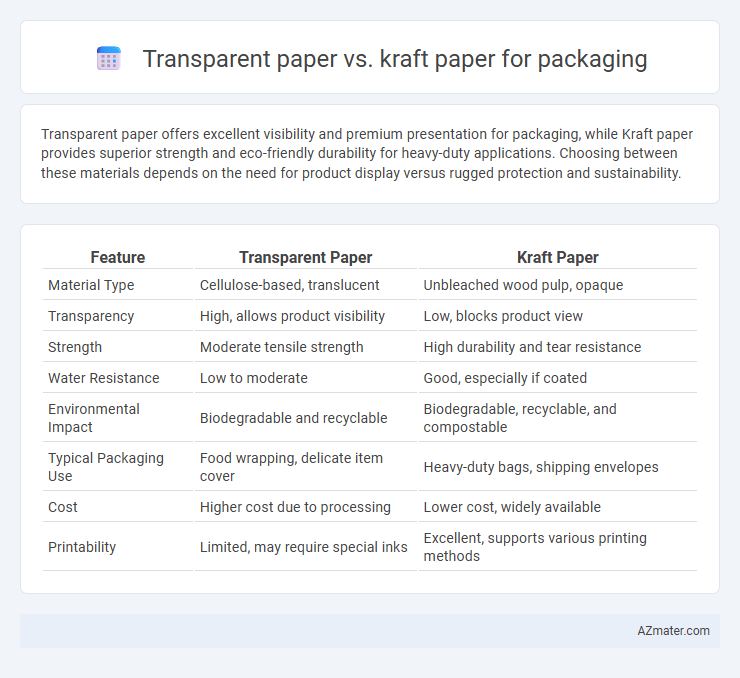Transparent paper offers excellent visibility and premium presentation for packaging, while Kraft paper provides superior strength and eco-friendly durability for heavy-duty applications. Choosing between these materials depends on the need for product display versus rugged protection and sustainability.
Table of Comparison
| Feature | Transparent Paper | Kraft Paper |
|---|---|---|
| Material Type | Cellulose-based, translucent | Unbleached wood pulp, opaque |
| Transparency | High, allows product visibility | Low, blocks product view |
| Strength | Moderate tensile strength | High durability and tear resistance |
| Water Resistance | Low to moderate | Good, especially if coated |
| Environmental Impact | Biodegradable and recyclable | Biodegradable, recyclable, and compostable |
| Typical Packaging Use | Food wrapping, delicate item cover | Heavy-duty bags, shipping envelopes |
| Cost | Higher cost due to processing | Lower cost, widely available |
| Printability | Limited, may require special inks | Excellent, supports various printing methods |
Introduction to Packaging Materials
Transparent paper offers superior visibility and moisture resistance, making it ideal for showcasing products while maintaining freshness. Kraft paper is renowned for its durability, eco-friendliness, and strength, often used for protective packaging and heavy-duty applications. Both materials serve distinct purposes in packaging, with transparent paper enhancing product presentation and Kraft paper providing robust, sustainable protection.
What is Transparent Paper?
Transparent paper, commonly known as tracing or glassine paper, is a smooth, semi-transparent material made by refining wood pulp to reduce opacity. It is widely used in packaging for its clarity, grease resistance, and ability to showcase product visibility, making it ideal for food wrapping and delicate item protection. Compared to kraft paper, which is thicker and opaque, transparent paper offers aesthetic appeal and functional benefits where visibility and moisture resistance are crucial.
What is Kraft Paper?
Kraft paper is a durable and biodegradable packaging material made from wood pulp through the kraft process, renowned for its high tear resistance and strength. It is commonly used in industrial and consumer packaging due to its natural brown color, flexibility, and eco-friendliness. Compared to transparent paper, kraft paper offers superior protection against external impacts and is favored for heavy-duty applications and sustainable packaging solutions.
Key Differences Between Transparent Paper and Kraft Paper
Transparent paper offers clear visibility of the packaged product, making it ideal for showcasing contents while providing moisture resistance. Kraft paper is known for its durability, tear resistance, and eco-friendly qualities, often preferred for heavy-duty packaging and biodegradable applications. The key differences lie in their appearance, strength, and typical use cases, with transparent paper emphasizing product display and Kraft paper prioritizing protection and sustainability.
Strength and Durability Comparison
Transparent paper offers moderate strength and is highly resistant to moisture, making it suitable for lightweight packaging that requires visibility and protection. Kraft paper provides superior durability and tensile strength, often used for heavy-duty packaging due to its ability to withstand rough handling and maintain structural integrity. Comparing the two, Kraft paper excels in tear resistance and load-bearing capacity, while transparent paper prioritizes clarity and moisture resistance without compromising moderate durability.
Environmental Impact: Sustainability and Recycling
Transparent paper offers excellent recyclability and biodegradability, making it a sustainable choice for eco-friendly packaging solutions. Kraft paper, derived from natural wood pulp, is highly renewable and widely accepted in recycling programs due to its durability and minimal processing requirements. Both materials contribute significantly to reducing environmental impact, with Kraft paper supporting circular economy practices and transparent paper promoting reduced plastic waste.
Aesthetic and Branding Potential
Transparent paper offers a sleek, modern aesthetic that enhances product visibility and boosts brand appeal by showcasing contents directly to consumers. Kraft paper provides a rustic, eco-friendly look that conveys sustainability and authenticity, strengthening brand identity for environmentally conscious markets. Choosing between transparent and kraft paper depends on the desired brand message and packaging goals, balancing visual impact with brand storytelling.
Cost Analysis: Transparent vs Kraft Paper
Transparent paper typically incurs higher costs due to specialized manufacturing processes and material purity requirements, making it more expensive than kraft paper. Kraft paper offers a cost-effective packaging solution with lower production expenses, derived from its simpler pulp treatment and abundant raw materials. Choosing between the two depends on budget constraints and the desired aesthetic or functional properties in packaging applications.
Applications in Modern Packaging
Transparent paper offers superior clarity and aesthetic appeal, making it ideal for premium product packaging such as cosmetics and food items where visibility is crucial. Kraft paper provides robust durability and eco-friendly attributes, favored in shipping, grocery bags, and heavy-duty packaging requiring strength and recyclability. Both materials meet modern packaging demands by balancing sustainability with functional performance tailored to specific industry needs.
Choosing the Right Paper for Your Packaging Needs
Transparent paper offers excellent visibility, making it ideal for packaging products that benefit from showcasing contents, such as food items or gifts, while Kraft paper provides superior durability and eco-friendliness suitable for heavy or sustainable packaging solutions. Choosing the right paper depends on product protection requirements, brand presentation, and environmental considerations, with transparent paper enhancing visual appeal and Kraft paper ensuring strength and recyclability. Businesses prioritizing product visibility often opt for transparent paper, whereas those focusing on robustness and sustainability lean toward Kraft paper for packaging needs.

Infographic: Transparent paper vs Kraft paper for Packaging
 azmater.com
azmater.com